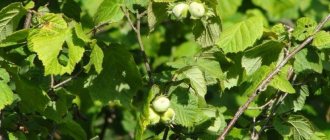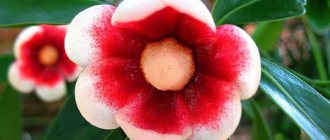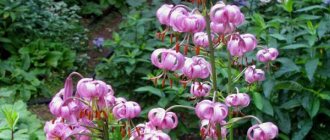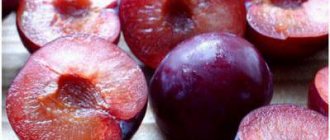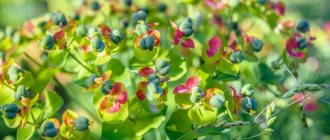0 1094
Russian gardeners increasingly began to plant wrinkled-looking roses on their plots. This phenomenon can be explained by the unpretentiousness of care and ease of planting of this plant. It is classified as a member of the rose hips and rose family. Miniature flowers are famous for their aroma with sweet notes, and the fruits for their beneficial properties. However, it is quite difficult to find this copy on the market.
Description of the Rugosa Rubra variety
The rose variety Rugosa Rubra is characterized by high resistance to diseases; the bush is almost not infected with fungus and is rarely attacked by insects. The shrub is distinguished by almost record-breaking frost resistance; the plant is in the second frost resistance zone and tolerates cold temperatures down to -45 degrees.
This means that the crop is suitable for growing in northern regions with harsh climates. The plant does not tolerate rain well; during periods of precipitation, not all buds open.
Rose Rugosa Rubra blooms from June to October intermittently; in the fall, large fruits appear on the bright bush, which can be eaten and various tinctures can be prepared from them.
| Color | Raspberry, purple |
| Number of flowers per stem | 3-5 |
| Aroma | Very strong |
| Flower size | 8-12 cm |
| Bush height | 150-200 cm |
| Bush width | 100-200 cm |
| Frost resistance | Frost-resistant, zone 2 |
| Powdery mildew resistance | Very good |
| Black spot resistance | Very good |
| Rain resistance | Average, in rainy weather not all buds open |
| Bloom | Reblooming |
| Bush shape | Spreading |
| Flower | Simple, 5 petals per bud |
Characteristics of a wrinkled rose
This variety of rose is a representative of the Rosehip family. The wrinkled rose is not too demanding to care for. Flowering shrub. The wrinkled rose is in great demand among summer residents and landscape designers in our country. This is a rather original and presentable plant that can perfectly complement your flower garden. Wrinkled rose has synonyms; it is also called wrinkled rosehip and rugosa rose.
In its natural environment, the wrinkled rose grows in Japan, China, Korea and the vast expanses of the Far East.
Today, the most popular varieties of wrinkled roses are white, pinkish and red-toned roses.
This variety of rose has a high degree of resistance to low temperatures, and can also tolerate dry weather quite calmly. In addition, the plant will not die if you accidentally overdo it with watering the soil.
The wrinkled rose blooms for quite a long time. The combination of these characteristics makes the wrinkled rose very popular among landscape designers and gardeners. This rose looks good both on its own and in combination with a variety of crops.
This rose will look good as a “living fence”. This rose is often used to decorate various areas, as well as city roads.
The plant is quite strong and spreading. The shoots grow straight. There are thorns of a reddish hue. They are shaped like needles. There are both small and large sizes. The shrub is quite tall, usually reaching two and a half meters in height.
The foliage of this shrub has a wrinkled surface and a bright green color. The lower part of the leaf blade is slightly pubescent and has a grayish green tone. As a rule, the length of the sheet is twenty-two centimeters.
The buds usually form separately, sometimes grouped in racemes containing about eight flowers. The color varies depending on the variety. The color palette ranges from delicate whitish-pink tones to deep red shades. The texture of the flowers is also different, there are terry varieties, and there are regular ones. The size of the bud varies from six to twelve centimeters.
The first signs of flowering begin to appear in late May - early June. The fruits are formed quite amicably. They are different in color, in the summer the orange tone predominates, and in the autumn they become lemon or burgundy.
The root system of the wrinkled rose is very well developed, located at a depth of about two to two and a half meters. The roots actively spread out to the sides for more than one meter and have many shoots. For this reason, wrinkled roses are sometimes planted to strengthen the soil in ravines and slopes.
The fruits are quite fleshy, quite large in size, about three centimeters in length. Over the course of one season, one plant usually produces three to four kilograms. Such fruits can be used for medicinal purposes, as well as in cooking.
Appearance and features
Rugosa Rubra rose belongs to the rose hip family. The flowers themselves are simple, with five wide petals and an open center with bright yellow stamens. The shade of the rose is bright crimson or purple.
Flowers do not fade in the sun and retain their shade until the end of flowering. Rose Rugosa Rubra blooms intermittently, each flowering is voluminous and long-lasting. Flowers are collected in clusters of 3-5 pieces, rarely blooming one at a time.
The petals are thin, velvety and wavy. Rugosa Rubra is also called a “wrinkle” rose because of its corrugated petals into small folds, similar to wrinkles. This variety has a pronounced, intense sugary-sweet aroma.
The Rugosa Rubra bush blooms in lush thickets. The plant will grow up to 2.5 meters. There are a lot of small folded leaves on the shoots. Leaves grow 5-7 pieces on one shoot.
The many flowers do not overlap the greenery, so the bush looks lush thanks to the abundance of leaves. The shoots are covered with small, thin burgundy thorns that are inclined downwards. Old branches acquire a woody color and become hard, young shoots are bright green.
Planting seedlings in open ground
Even beginners and inexperienced gardeners can cope with planting wrinkled roses. Being included in the category of plants that are completely undemanding to the soil and place of growth, it also easily tolerates sudden changes in temperature and drought, but in order to obtain the most beautiful and rich color of flowers, it is better to take care of creating the most optimal conditions for its growth and development.
Selecting a location
Wrinkled rose is an undemanding plant, but it feels most comfortable in bright sunlight, so a well-lit, south- or west-facing slope that is well-lit and protected from the wind is suitable for planting the bush.
Soil moisture for the Rugosa rose is also not a decisive factor, but for the fastest growth and development it is better to use a substrate with a low acidity level.
When planting shrubs in alkaline soil, it will be necessary to regularly apply mineral fertilizers, since such a soil composition will not be able to fully nourish the plant.
Important! Despite the fact that Rugosa leaves are quite dense and tough, they are very easy to burn, so caring for roses using chemicals is carried out with extreme caution.
Layout and depth
The most suitable time for planting a plant is considered to be early spring, before the buds open, but planting in the fall is also acceptable, if the characteristics of the variety allow. Depending on the purpose of the procedure, the distance between seedlings may be different:
- if we are talking about creating a hedge, in this case it is necessary to make an interval of at least 70 cm;
- if the bush is planned to be planted alone, it is recommended to build a vertical fence, for example, with sheets of roofing iron, maintaining a distance of 2 m between plantings;
- group plantings of Rugosa roses with other plants require a mandatory distance of 1.5 m.
The depth of the hole is usually 40–50 cm. Before the planting process itself, the soil will need to be well fertilized by adding a bucket of peat or humus to one hole.
To avoid drying out, immediately after planting the seedlings, the substrate is abundantly watered and mulched, and the shoots must be shortened by one third. After all the necessary procedures have been carried out, the seedlings will need to be shaded from the sun for the first few weeks of rooting to protect them from burns on the leaves. You will probably be interested in learning how to grow roses from seeds.
Growing and care
Rugosa Rubra rose is an unpretentious plant, so it is often planted in park areas and squares, where it will grow with minimal care. To plant a plant, it is better to choose seedlings from cuttings; you can grow rose hips from seeds, but this process is very labor-intensive and often not successful.
It is advisable to place the shrub in the sun, but the crop grows well in the shade. It is recommended to hide the rose in the shade in the first days after planting. Before planting, you need to add humus, superphosphate and potassium salt to the soil.
The soil is watered, but not waterlogged. Afterwards, prepare a hole 15-20 cm deep. After planting, the tree trunk circle needs to be mulched and the plant watered. Planting can be done both in spring and autumn. The optimal period is the beginning of spring before the buds awaken.
In the first year, the Rugosa Rubra shrub needs to be watered abundantly. An adult plant is more resistant to hot weather, so watering can be reduced. The shrub needs 4 waterings over the entire summer season.
During dry periods, it is recommended to increase watering to once every two weeks; an adult rosehip requires 20 liters of warm water. In the second year after planting, the plant needs to be fertilized.
Three seasonal feedings are carried out: at the beginning of the spring season, at the end of June (the period of active flowering and shoot growth), at the beginning of autumn. Once every three years, organic fertilizer, humus or compost must be applied to the plant.
After fertilizing, it is necessary to water and loosen the area and mulch the soil. The first pruning of the plant is carried out when it reaches three years of age. Diseased, dry and old shoots need to be pruned from perennial shrubs.
Rules for propagating wrinkled roses
There are three main methods for propagating wrinkled roses:
1) Using seeds. This is not a very effective method because the desired characteristics of the plant may be lost.
2) Using root shoots. To do this, they dig up offspring that have grown thirty to forty centimeters. The rhizome is trimmed using a shovel. You don’t have to do this procedure, but simply form adventitious roots by hilling the area. You also need to add a certain amount of humus and pour plenty of water. A year later in the fall, you can trim the roots of the bush, which grows along with the stems, leaving fifteen centimeters.
3) Using cuttings. Young cuttings are harvested in early June. They need to be cut from the bush along with 3 nodes. Be sure to remove any foliage from the bottom. To ensure that the cuttings take root well, treat them with Heteroausin. Before planting, add fertilizer to the soil. Cuttings need to be planted to a depth of ten to fifteen centimeters. There should be at least one and a half meters between the plants themselves. Then water the soil thoroughly and cover with film. Leave one third of the total length of the plant.
Pests
Microscopic spiders have appeared on the plant, and the rose is gradually becoming covered with cobwebs, what should I do?
Spider mite
Are small green insects destroying your rose? Effective methods of pest control.
Green rose aphid
Caterpillars have appeared on the rose and are twisting the leaves of the plant, how to deal with the pest
Rose leaf roller
Flat bumps have appeared on the shoots of the rose or on the underside of the foliage, how to deal with the pest
Rosen scale insect
At 5 years old, no more than 20 strong shoots are left on the rose. All shoots that have reached 7 years must be removed. The fruits of the Rugosa rosehip can be eaten, dried for brewing as a drink, or made into medicinal infusions.
Fruit harvesting should be carried out from August to October. The first frosts take away the beneficial properties of the fruits, so there is no point in collecting them after frost. Rugosa Rubra is a thorny plant, so it is necessary to handle it and collect the fruits only with pilot, rubberized gloves.
Photo and description
Rugosa is a spreading shrub. Depending on the variety, its size can reach a height of 45 to 210 cm.
Annual plants have green, grassy shoots, while perennials are woody brown. Contains spines: small, needle-shaped and large, widened at the base.
The odd-pinnate leaves with stipules and petioles have an alternate arrangement. From 7 to 9 pieces of leaves are located on one petiole. The shiny green surface of the leaves is oval in shape with jagged edges, in contrast to the lower surface, which is pubescent and gray in color.
Depending on the species, the flowers are single or collected in inflorescences of 2-4 on a peduncle. The color scheme is varied: white, yellow, pink, red, etc. Fragrant flowers are five-membered and actinomorphic.
The spherical fruit of Rugosa in the form of a prefabricated nut is covered with a pericarp. Ripe fruits are red or orange. The plant grows underground woody shoots - turions, forming a caudex.
Useful tips
- The Rugosa Rubra shrub reacts poorly to autumn pruning. It is recommended to start pruning before sap flow begins. Significant shortening of the shoots will lead to the appearance of young shoots that will not bear fruit;
- The plant can become infected due to improper agricultural practices. When fungal diseases appear, it is recommended to treat the shrub with fungicides or fight the disease with folk remedies. If the rose is significantly affected, it must be removed from the site to avoid infecting other crops;
- The rose can become a victim of insects. The most common are caterpillar larvae, spider mites, roseate aphids, and bronze aphids. It is necessary to combat parasites with the help of insecticides and acaricides.
Plant resistance to diseases and pests
The wrinkled rose is highly resistant to diseases and pests. If recommendations on how to care for rose hips are not followed (lack of light, fertilizer, humidity, nutrition, or vice versa, excess), the plant weakens. Under such conditions, plant resistance to many diseases and insect pests decreases. Most often, wrinkled roses are susceptible to fungal diseases such as powdery mildew, rust, gray and brown rot. Among the pests, the plant can be attacked by spider mites, leaf rollers and sawflies.
Therefore, in order for rose hips to please for a long time with its rich decorative flowering, and its cultivation and care to bring only positive emotions, it is very important to follow agrotechnical recommendations. If diseases and attacks of parasites could not be avoided, treatment with insecticides “Aktellik”, “Karbofos”, “Metathion”, “Rogor”, etc. in early spring, before the buds swell, will help.
You can also spray the rose with a kerosene solution: 2 g per 10 liters of water.
Pros and cons of the Rugosa Rubra variety
Advantages:
- Bright flowers abundantly covering the green bush;
- Long flowering;
- The presence of healthy and bright fruits;
- Low maintenance requirements;
- Pronounced, persistent aroma;
- Rarely gets sick;
- Increased frost resistance, does not require shelter for the winter.
Flaws:
- Many sharp thorns;
- Does not tolerate rainy weather well.
Rose rugosa: growing features (video)
Most hybrids and varieties of Rósa rugosa have repeat flowering, which is very important when used in landscape design, which includes:
- hedges, borders and environmental barriers;
- group dendrological compositions;
- tapeworm plantings on lawns;
- rockeries with live or artificial stone;
- ethnocompositions.
Rugosa rose is in high demand as a natural barrier to strengthen coastal zones, as well as an environmental barrier in industrial zones and areas with high gas pollution.

